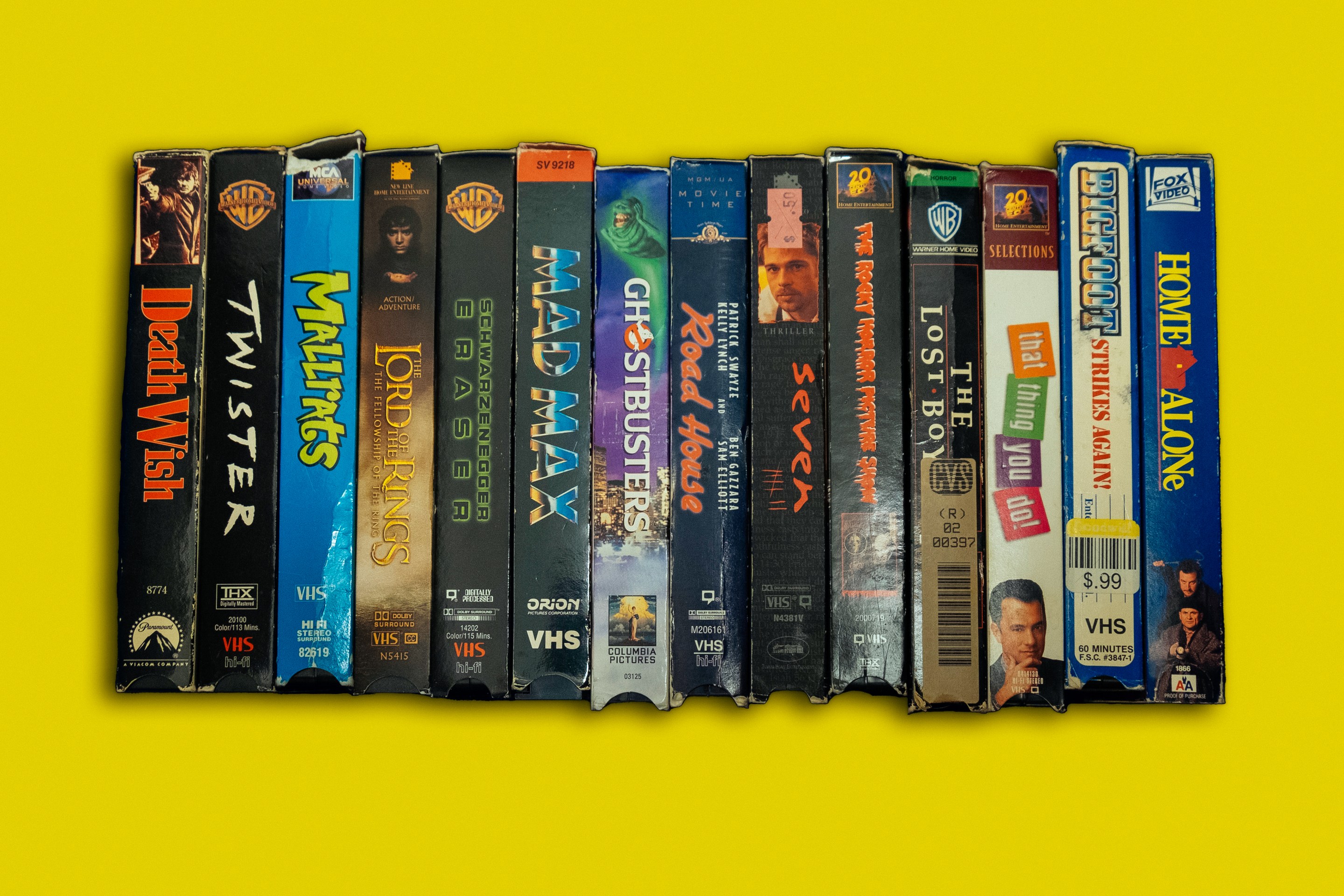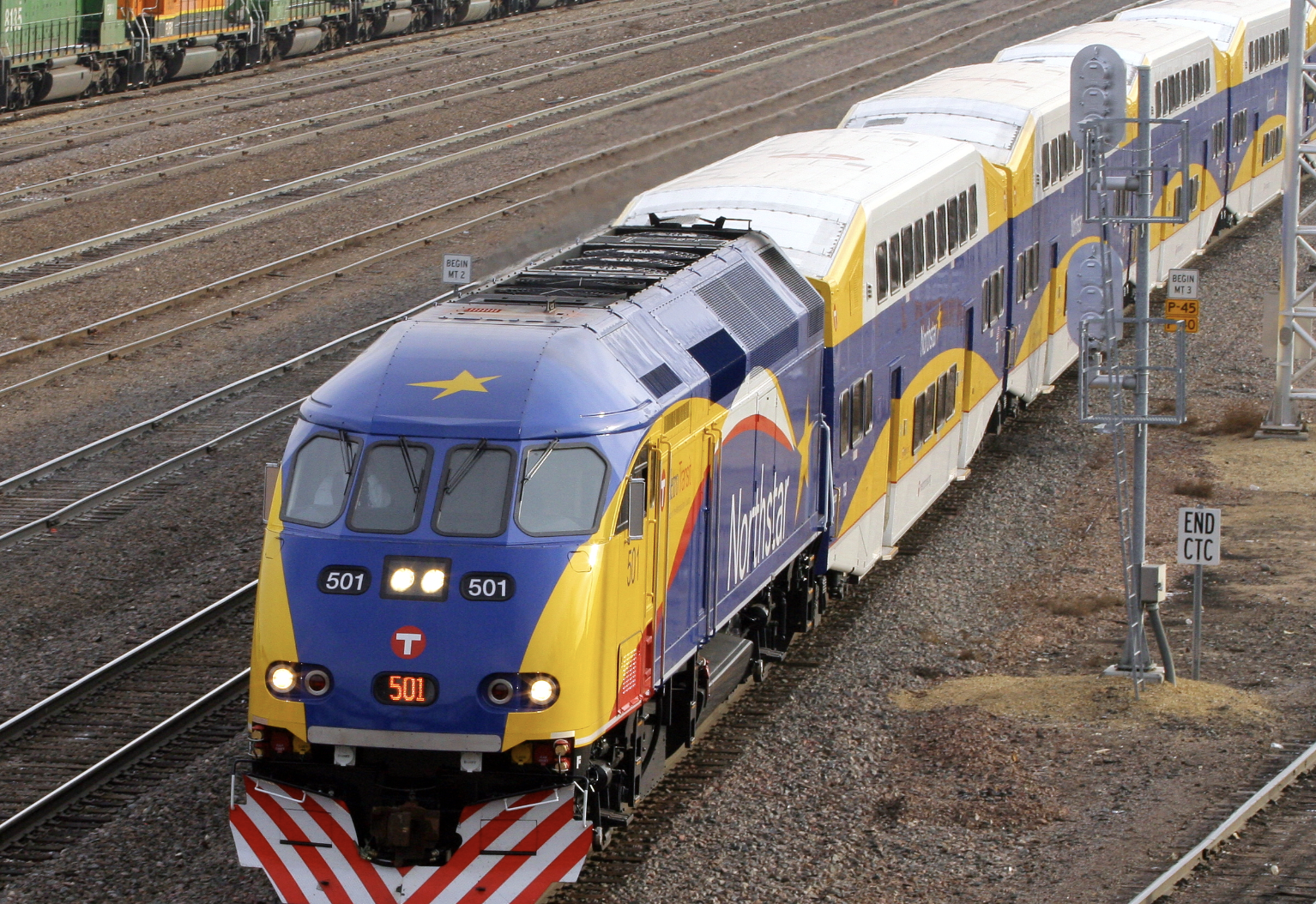The year is 2021, and I’m on my way to rent some VHS tapes.
Video Universe is situated in a quiet Robbinsdale strip mall, along with unassuming chains like Snap Fitness and Broadway Pizza. Walking through the front door, with its after-hours return slot, feels like stepping through a portal to 1995.
A light-up sign on the right-hand wall lists new releases and coming attractions. Head to the left, past the signs for special interest and martial arts and foreign movies, and you’ll find the 18+ adult movies section, with a poster of James Bond on the door. In between are thousands of movies for rent, mostly DVDs and Blu-Rays, and piled high on the tops of some shelves or crammed in on the bottom of others, you can also find hundreds of VHS tapes.
This is one of the last independently owned video stores in the country. The worn green carpet looks like it’s been walked on for decades.
I don’t remember how I heard about Video Universe, only that I did, and after reading reviews like, “the only place within 500 miles where I can rent a VHS of Nail Gun Massacre,” I knew I had to go. A few weeks after I successfully rented a handful of VHS titles—for the first time since… what, 2000?—I called the store to talk. As a lover and collector of VHS tapes, I still had to ask why on earth anyone continued to rent them out.
“Why do we continue to carry them? Well, we’ve still got space for them,” owner Scott Prost says, laughing. There are people who take advantage of their five tapes for $10 deal. Other folks are looking for things they can’t find in any other format. Sifting through the stacks of VHS tapes in the recent returns pile, he says that “for the most part, most of these we don’t have on DVD.”
“And now,” he adds, “people want to buy them. There’s kind of this huge, cult collectability.”
Maybe you haven’t touched a tape in decades, but there are plenty of collectors out there. And as we get further from the death of the format, they’re moving out of the underground: In mid-August, a Free Blockbuster went up outside of Heroic Goods & Games in south Minneapolis. It’s the third such movie-sharing kiosk in Minnesota, and one of dozens across the United States.
I have a hunch that VHS just might, in spite of its many flaws, be poised to make something of a comeback. And before we hang up, I ask Prost what I’ve been asking all kinds of people, including myself, over the last few weeks: Why does he think people continue to collect VHS tapes? What’s the point?
He laughs, then falls quiet for a moment. At 66, he says eventually, it’s hard for him to get into the headspace of the millennial collectors who come around looking for tapes. Tapes are cumbersome and noisy. They’re loud and bulkier than most books. They take forever to rewind. The picture is… not great.
“I don’t know! I don’t know what it is about it. I don’t know what the allure is,” he says. “I guess I should ask the people who come in and buy them.”
When the VHS videocassette format came to North America in 1977 it was a technological marvel, letting people watch whatever they wanted whenever they wanted for the first time in history. Hollywood executives worried that this home video concept would hurt their bottom line, keeping people out of theaters, but it never did. It actually seemed to make people love movies more.
After beating out Betamax in the "format wars," VHS held on into the 2000s, even as DVDs hit the market with their shiny promises of scene-skipping, bonus features, and less-grainy picture quality. The last major motion picture released on VHS was A History of Violence, in 2006 (which I think David Cronenberg probably appreciates, explorer of the intersection between man and technology that he is).
The last existing manufacturer stopped making VHS tapes in 2008, and they quickly became obsolete. That year, Jim Henderson, co-owner of Los Angeles record-shop institution Amoeba Music, told the LA Times that unlike vinyl records, “no one seems to cling to VHS for romantic reasons.”
Some of us still did, of course, and some of us still do. When I lived in Boston in my twenties, my roommates and I spent plenty of nights gathered around a hulking silver Panasonic television, the kind that has built-in VCR and DVD players. Generally too broke to go out to the bars, we’d spring for a six-pack each and watch a few of our two-dozen tapes—Slap Shot or Halloween, Airplane!, or Indiana Jones.

VHS fans didn’t disappear, they just retreated to their living rooms, and to the internet trading posts frequented by every obsolete object collector: eBay, Craigslist, Facebook Marketplace. They created communities like the VHS subreddit, which has about 25,000 “tapeheads” in its ranks. There are Facebook buy/sell/trade groups for every kind of collector. Some encourage shitposting and meme sharing, others are more like VCR: VHS Collector’s Resource, which asks its members to “please keep horseplay to a minimum.”
Dan Hoffstrom, vocalist for the local hardcore band Murf, says the community of likeminded collectors is one of the things he loves about the format. Last year the members of Murf released a full-length VHS of their own, Nasty Nasties, a compilation of cross-cut, largely unscripted vignettes. They spent a year, on and off, filming the shots, “forming chaotic universes together,” and editing the footage.
But it’s a lot more than the community for Hoffstrom. It’s the art on the cardboard sleeve, the mechanics of the tape itself. It’s the uncut nostalgia that comes with seeing the previews and commercials before the feature.
“I have this copy of Teenage Mutant Ninja Turtles, and there’s this great Pizza Hut commercial, or there’s this amazing Diet Coke ad before Batman 1989, where Alfred’s on the phone and he’s like, ‘Batman ran out of Diet Coke,’” he laughs. “Shit like that just, like, brings me joy. That makes me super happy.”
Taken from trailer to end credits, VHS tapes are an actual time capsule, more of a historical artifact than almost any other kind of entertainment. My roommate’s 1992 copy of Wayne’s World began with a preview for Ridley Scott’s 1492: Conquest of Paradise—one of two Christopher Columbus movies released that year—followed by a Magic Johnson PSA about the AIDS crisis.
John Moret, lead programmer at the Trylon Cinema and the owner of about 5,000 movies across various formats, including VHS, says that the physical nature of tapes is part of what he loves about cinema in general. The physicality of touching something, the ritualistic nature of sliding the tape into the VCR—he says that the whole process connects your body to the material in a different way.
“Being a projectionist, there’s something to me about a movie as a performance,” Moret says. “You have to thread every reel, your changeovers have to be clean, you have to make sure it’s in frame, make it in focus. To me, VHS tapes have a similar quality.”
Paul Zenisek, the owner of Heroic Goods & Games and keeper of its Free Blockbuster, says they’ve had tapes on store shelves since the day they opened about four years ago, “but that section of the store has expanded a great deal, and I actually see it growing in popularity.” The quality may not compare to vinyl, but he thinks tapes trigger the same feelings—and of course, there’s the drama and fun of hunting for a physical object with emotional attachment.
And more and more new collectors fall for VHS every day—folks like Brandon Holz of Winthrop, Minnesota, a small town about an hour west of the Twin Cities. Holz grew up a horror fan. He remembers watching Night of the Living Dead and Trilogy of Terror with his dad.
“I didn’t get to see my dad a whole lot as a kid,” Holz says. “But whenever I saw him we’d rent horror tapes from our local mom and pop store.”
He didn’t start collecting until about three years ago. The first one he remembers buying as an adult is Alien (his favorite movie of all time). “I popped it in and this wave of nostalgia hit me, and I was like, ‘Okay, I should get more tapes.’” He even started a YouTube channel to document his VHS collecting journey.
In reporting this story I talked with many delightful tape obsessives. There’s Jesse Ellis from Washington, D.C., whose tapes have followed him through three states, four relationships, and about six apartments. When he moved from Ohio to Seattle a few years back, he could only take what fit in his Honda Accord. “So I decided I'd buy all the household essentials in Washington state, and I filled my car with as many video tapes as I could bear.”
There’s Cory Casciato, a former arts and entertainment writer for places like The AV Club, who started his collection in early 2019. A musician, Casciato wanted to see if he could record to magnetic VHS tape like reel-to-reel tape. His obsession now is in buying tapes people have recorded from television; he owns hundreds. Why? Because when you watch 70 to 100 tapes someone’s recorded from TV, you can really get a sense for who that person is, or was.
“It’s weird, and a little voyeuristic—I’ll just acknowledge that up front,” Casciato laughs. “You’re gonna be like, ‘Wow, this sounds a little voyeuristic,’ so I’ll just acknowledge, yeah, there’s definitely an element of voyeurism to it.”
But plenty of collectors are people like Kat Naden, owner of Duck Duck Coffee on 38th Street in Minneapolis. When I reached out about talking tapes after seeing a comment from Duck Duck on a post about the Free Blockbuster, she responded that she didn’t know how much she had to add: “I just like ’em, is all.”
“I still don’t know how to use a tracking button on a VCR—don’t know if it really does anything or which direction you’re supposed to go in,” Naden laughs.
“They’re putzy, right?” Moret says. “And they’re heavy and they’re big and they’re a pain. But if you grew up with them, there’s something about them that feels very much like how you fell in love with movies.”
Maybe no one was clinging to VHS in 2008, but people are certainly romantic for them now. You know… vinyl records didn’t have their renaissance until a decade after that format became obsolete, either.
There are dozens of nostalgic reasons to love VHS. Fuzzy, warm feelings for a fuzzy, warm format.
But plenty of collectors out there, nostalgic though they may be, have additional, practical reasons for lovingly hoarding tapes.
For one, the internet is a pretty big place—but it’s not limitless. There are thousands of movies once released on VHS that you can’t find streaming anywhere. Some of the most expensive tapes out there—the ones that go for $1,000 or more, like Journey Into The Beyond and Don’t Open the Window—are things you literally can’t watch anywhere else. (Don’t even get me started on the cost of VCRs; out of production since 2016, they go for hundreds of dollars these days.)
In 2019, GQ ran a story about how “You Can’t Stream Your Favorite Movie Anymore,” and they’re right—there are so many mainstream hits and cult classics you just can’t watch online. I was recently looking for a way to watch The Heartbreak Kid, for example, a 1972 comedy about a newlywed who falls in love with someone else on his honeymoon. It’s not streaming on Amazon or anywhere else (though there’s a full rip on YouTube). It is available on VHS—if you’re willing to pay $57. Used DVD copies go for $85 or more.
And where was I eventually able to find it? Why, they had a copy at Video Universe.
“Every time a new format comes about, you’re losing another percent of culture,” says Troy Rachey, who’s been working at the Robbinsdale video store since he was a teen in 1996. Not all movies made it from VHS to DVD; many of those that were put on DVD didn’t get transferred to Blu-Ray. “That’s why we kind of fill that void,” Rachey says. “We get those people that, ‘Oh, well I couldn’t find it anywhere else.’ Well, that’s why we’re still here.”

Brian Morrison, the creator of the Free Blockbuster movement, says he did it to “combat the myth of scarcity,” around tapes. The idea behind these video sharing libraries is that tapes should get used rather than sitting around in a box in a basement somewhere. “There’s no reason we can’t just share them and have a collective approach to how we manage our possessions rather than the individual approach,” Morrison says. On the other hand, of course, “There’s something to be said for owning things.”
“The thing about physical media is, someone can’t just decide to take it off the internet tomorrow,” he says. “That really is a problem with this whole streaming revolution.”
To clarify, Morrison has no problem with streaming—we have access to more movies now, and more easily, than ever before. But unless you own something, you’re at the whims of platforms, which come and go. Movies get bumped from one platform to another; flukes of licensing have rendered movies unwatchable for weeks, months, years, or indefinitely.
He’s seen it firsthand, working for short-lived streaming services like Crackle and Quibi. “And I will tell you that I’ve worked on multiple projects that are no longer accessible by anyone,” he says, or that have disappeared and popped up again later. One Quibi show he worked on just came back as a “Roku original.”
“And it’s only going to get stupider,” he chuckles.
Streaming services are watching you, too. The New York Times has reported on the “digital daisy chain of data-gathering on viewers,” and you’re paying Netflix monthly for the privilege of collecting all kinds of data about you, from what you watched to when you watched it to how long you watched it. Putting in a tape or a DVD is a way to truly unplug. Plus, you can’t lend a digital thing you’ve bought to a friend. Owning a physical copy, Morrison believes, actually prioritizes sharing.
In some ways, owning media can feel like a real rebellion against a culture where nothing is tangible and nothing is real. “It’s getting faster every day, with stuff like Zuckerberg—that dork’s, like, Metaverse—we’re getting farther and farther away from a tangible reality,” says Murf’s Dan Hoffstrom. And it’s fun to have around the house. He rattles off some of the titles surrounding him in the basement: Caddyshack, Time Cop, Tequila Sunrise, “some crappy movie called The Dead Hate the Living.”
And there’s something to be said for preservation, too: “There are people out there saying, ‘I think this lenticular cover on Jack Frost is important and should be preserved as a work of art,’” Free Blockbuster’s Morrison says.
At Saving Tape Media Conversion, a video and audio conversion service in south Minneapolis, Thor Anderson deals with “buckets and buckets and buckets” of VHS tapes every day.
And even though his business is in transferring tapes to a digital form, he sees there’s often value in the physical thing. Some of his customers, he imagines, get rid of their tapes when the transfer is done. But people often bring in tapes “that have been very, very lovingly marked,” tapes that are covered in little stickers or handwritten notes.
“Then the physical tape itself takes on a special significance,” he says. “That’s the kind of thing, I imagine someone’s going to keep that.”
Among the obvious pro-streaming counterpoints, of course, is that tapes are decaying all the time. The fragile nature of the format is one of the things that spurs sentimentality in collectors. It’s no doubt one of the things Saving Tape’s clients are worried about.
Moret and Morrison are ideologically aligned in their belief that the temporary-ish nature of film means we need to share it. In addition to his work at the Trylon, Moret is a member of a group called the Cult Film Collective, which has spent the last few years working on an idea called the Cult Video Collective.
They envision an eventual co-op of tape sharers, with an online database where collectors could list their libraries and trade back and forth. “I’m hoping we’re not the only people with those types of ideas,” Moret says. “I’d love to see video stores kind of make a comeback, because it’s worth it.” And maybe someday, realizing that there are other weirdos out there who want a way to watch VHS tapes, some sort of boutique company will even pop up to make new VHS-playing machines.
The temporary nature is true of just about all physical objects, and that’s part of what makes the things we cherish special. Your favorite tape could get eaten tomorrow; every time Moret screens something on 16 mm or 35 mm film, the print itself is scratching and breaking, getting worn out.
“I know that every time I’m showing it, it’s slowly dying,” he says. “But it otherwise has no purpose. it needs to be shown to have value, otherwise it’s nothing.”






